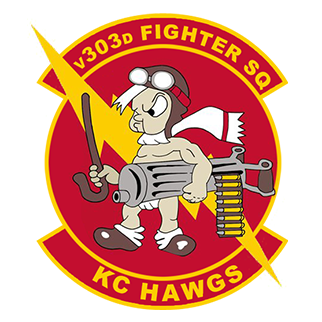F-16C/D Fighting Falcon
The F-16C and F-16D aircraft, which are the single- and two-place counterparts to the F-16A/B, incorporate the latest cockpit control and display technology. All F-16s delivered since November 1981 have built-in structural and wiring provisions and systems architecture that permit expansion of the multirole flexibility to perform precision strike, night attack and beyond-visual-range interception missions. All active units and many Air National Guard and Air Force Reserve units have converted to the F-16C/D, which is deployed in a number of Block variants.- Block 25 added the ability to carry AMRAAM to the F-16 as well as night/precision ground-attack capabilities, as well as an improved radar, the Westinghouse (now Northrop-Grumman) AN/APG-68, with increased range, better resolution, and more operating modes.
- Block 30/32 added two new engines -- Block 30 designates a General Electric F110-GE-100 engine, and Block 32 designates a Pratt & Whitney F100-PW-220 engine. Block 30/32 can carry the AGM-45 Shrike and the AGM-88A HARM, and like the Block 25, it can carry the AGM-65 Maverick.
- Block 40/42 - F-16CG/DG - gained capabilities for navigation and precision attack in all weather conditions and at night with the LANTIRN pods and more extensive air-to-ground loads, including the GBU-10, GBU-12, GBU-24 Paveway laser-guided bombs and the GBU-15. Block 40/42 production began in 1988 and ran through 1995. Currently, the Block 40s are being upgraded with several Block 50 systems: ALR-56M threat warning system, the ALE-47 advanced chaff/flare dispenser, an improved performance battery, and Falcon UP structural upgrade.
- Block 50/52 Equipped with a Northrop Grumman APG-68(V)7 radar and a General Electric F110-GE-129 Increased Performance Engine, the aircraft are also capable of using the Lockheed Martin low-altitude navigation and targeting for night (LANTIRN) system. Technology enhancements include color multifunctional displays and programmable display generator, a new Modular Mission Computer, a Digital Terrain System, a new color video camera and color triple-deck video recorder to record the pilot's head-up display view, and an upgraded data transfer unit. By mid-1999 Block 50/52 [aka Block 50 Plus] F-16s will carry the CBU-103/104/105 Wind-Corrected Munitions Dispenser, the AGM-154 Joint Stand-Off Weapon, and the GBU-31/32 Joint Direct Attack Munition.
- Block 50D/52D Wild Weasel F-16CJ (CJ means block 50) comes in C-Model (1 seat) and D-Model (2 seat) versions. It is best recognized for its ability to carry the AGM-88 HARM and the AN/ASQ-213 HARM Targeting System (HTS) in the suppression of enemy air defenses [SEAD] mission. The HTS allows HARM to be employed in the range-known mode providing longer range shots with greater target specificity. This specialized version of the F-16, which can also carry the ALQ-119 Electronic Jamming Pod for self protection, became the sole provider for Air Force SEAD missions when the F-4G Wild Weasel was retired from the Air Force inventory. The lethal SEAD mission now rests solely on the shoulders of the F-16 Harm Targeting System. Although F-18s and EA-6Bs are HARM capable, the F-16 provides the ability to use the HARM in its most effective mode. The original concept called for teaming the F-15 Precision Direction Finding (PDF) and the F-16 HTS. Because this teaming concept is no longer feasible, the current approach calls for the improvement of the HTS capability. The improvement will come from the Joint Emitter Targeting System (JETS), which facilitates the use of HARM's most effective mode when launched from any JETS capable aircraft.
- Block 60 - In May 1998 the UAE announced selection of the Block 60 F-16 to be delivered between 2002-2004. The upgrade package consists of a range of modern systems including conformal fuel tanks for greater range, new cockpit displays, an internal sensor suite, a new mission computer and other advanced features including a new agile beam radar.
The Mid-Life Update (MLU) is an avionics modification program for the F-16 Block 15 A/B and is based primarily upon common requirements of the European Participating Governments (EPG) through the F-16 Multinational Fighter Program (MNFP) Steering Committee. The members of the F-16 MNFP are the Belgian Air Force (BAF), the Royal Danish Air Force (RDAF), the Royal Netherlands Air Force (RNLAF), the Royal Norwegian Air Force (RNoAF), and the United States Air Force. The MLU program evolved from the Agile Falcon/MLU pre-development stage, which began in January 1988. Transition to MLU Engineering and Manufacturing Development (EMD) began in January 1990. The EPG elected during EMD to develop and buy aircrew trainers, Unit Level Trainers (ULTs) and Weapon System Trainers (WSTs). In October 1992, the US announced its withdrawal from the production phase of the MLU; and, in 1995, Denmark announced its withdrawal from the MLU trainer program with the intent to purchase directly from Hughes Training, Inc. (now Raytheon Training, Inc.). The MLU trainer program was established to support the remaining European Participating Air Forces (EPAF). The MLU trainer contract was awarded in June 1995 to Lockheed Martin Tactical Aircraft Systems (LMTAS) in Ft. Worth, Texas, with the majority of the effort for both hardware and software development and integration being done by LMTAS's prime sub-contractor, Thomson Training and Simulation, Ltd. (TT&SL) in Crawley, England. The contract calls for a total of 12 trainers to be delivered to the EPAF, and one Training System Support Center (TSSC) at LMTAS. European participating industries competed equally for subcontracts on the F-16 Mid-Life Update Program. European participating industries were awarded a total of $303.3 million of the $380 million available for foreign manufacture on the F-16 Mid-Life Update Program. Contractors complied with the Federal Acquisition Regulation and the Defense Federal Acquisition Supplement in the solicitation, source selection, and award process for subcontracts on the F-16 aircraft Mid-Life Update Program. European participating industries who were not awarded subcontracts: had smaller production bases than U.S. companies; did not have nonrecurring costs subsidized by their respective European governments; could not overcome U.S. companies' technical advantages; or did not receive follow-up contracts for research and development on the F-16 Mid-Life Update Program.
The Common Configuration Implementation Program (CCIP) for the USAF's F-16C/D fleet will provide significant avionics upgrades to Block 40 and 50 F-16s, ensuring their state-of-the-art capability well into the 21st century. A key element of the upgrade is a common hardware and software avionics configuration for these two blocks that will bring together the Block 40/42 and 50/52 versions into a common configuration of core avionics and software. The avionics changes consist of the following systems: Link 16 Multifunctional Information Distribution System (MIDS), Joint Helmet-Mounted Cueing System (JHMCS), commercial expanded programmable display generator, color multifunction display set, modular mission computer, mux loadable data entry display set and an electronic horizontal situation display. This package contains a number of systems being incorporated into European F-16s in the F-16A/B Mid-Life Update program.
The Air Force will soon be flying only Block 40/42 and Block 50/52 F-16s in its active-duty units. Block 25 and Block 30/32 will be concentrated in Air National Guard and Air Force Reserve units.



